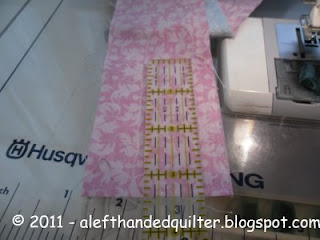LEFT-HANDED QUILTING – BINDING – PRE-PACKAGED - PRE-FOLDED
============
Note - these instructions are written in LEFTISH.
If you are right-handed - just reverse the directions.
============
This little demo will show you how I put the binding on my Hawaiian Applique Hibiscus – Red on White – UFO – using pre-packaged – pre-folded
Wrights® Double Fold Quilt Binding –
It comes pre-folded – off-center – so one side is a tad bit wider than the other.
The narrower side is “supposed to” go on the “top” -
and the wider side is “supposed to” go on the “bottom” –
so that the stitching is covered when the binding is sewn to the front and folded to the back.
You all know by now that I don’t necessarily do what I’m “supposed to” do –
so you wouldn’t be surprised if I didn’t do it the way you’re “supposed to”
BUT – in this case – I am going to do EXACTLY what I’m “supposed to” do –
only I’m going to do it BACKWARDS.
I told you
before that I usually sew my binding to the back and then fold it to the front –
So –
I’m going to find the wider side – sew it to the back – and then fold it to the front
Just like I showed you all before –with just a few minor differences.
First – because the piece is so raggedy –
(It’s only been in the UFO pile for 32 years - since 1979 –
It’s probably older than some of my readers – Yikes!!)
I flipped it over to the back side - and marked a line in blue around the outside of the appliqué –
and another line an inch away from that –
The outermost line will be a “placement” line – NOT sewing line –
It will show me where I want to “place” the binding as I stitch it down
(I don’t like to trim my piece until AFTER the binding is on – just in case.)
Unfold the wider side and pin it to the back of the piece –
See the fold line? Isn’t it cute? That’s what I’m going to sew on –
See the fold line at the bottom?
If I make a diagonal fold and line that up with the blue line I drew on the edge of the piece –
It will “mark” my needle stopping point - right THERE at the top –
Take a couple of backstitches -
Remove the piece from the sewing machine –
Fold the binding UP -
And then back DOWN –
Lining up the edge of the binding with the blue line on the edge of the piece -
And pin it -
And stitch it –
From the “front” – since I’m doing it back to front -
What the miter will look like -
I left long “tails” like before – at the beginning and end -
Unfold the binding prefolds – and match up the ends -
Press a crease in both sides as a stitching guide -
PIn the ends together -
Stitch the seam and test it – BEFORE YOU TRIM THE SEAM –
Nope – don’t like it – a little loose on the fit -
Redo it – MUCH BETTER!
OK – NOW I can trim that seam –
And press it open -
Aren’t those miters going to be pretty?
View from the front – looking GOOD!
OK – NOW I trim the batting and backing (actually the front) even with the binding –
All trimmed up -
Fold the binding to the front -
Pin the first side -
And the bottom -
Make the miter - remember "bottoms up" -
Pin it -
Stitch it -
I chose my decorative "blanket stitch" - and - because it "zigs" the wrong way -
I have to set my machine to "mirror" the stitch "left to right".
THANKS, ROSE!! - for making me aware of the fact that I neglected to mention this step before - SO SORRY!!
Always test the stitch first - to make sure it does what you want it to do -
and goes the way you want it to go!!
All done!!
Close-up from the front -
Close-up from the back -
Missed some spots – but overall not too bad -
Add some twill tape and a chopstick -
And it’s ready to hang -
As a side note - here’s a link to a site that explains the difference between Single-Fold Binding and Double-Fold Binding – if you’re interested –
DIFFERENCE BETWEEN SINGLE FOLD AND DOUBLE FOLD BINDING
So - according to this site -
DOUBLE FOLD is the stuff we make -
and fold ONCE before we sew it to the quilt
and -
SINGLE FOLD is the stuff made by bias tape makers
(or prepackaged as DOUBLE FOLD) -
and has TWO folds in it.
And they wonder why we're confused!!!
Talk to you later – gotta go – gotta sew –















































